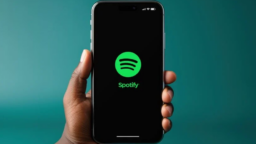Spotify‘s latest earnings report, released Tuesday (July 25), showed the company beating guidance on numerous fronts, including monthly active users and Premium subs.
The platform’s MAUs soared by 36 million in Q2 to 551 million, a 27% YoY increase, while the number of paid subscribers jumped 10 million to hit a total of 220 million (a 17% YoY increase).
And the music streaming service reported an adjusted operating loss of €112 million, about 13% less than its guidance of €129 million for the quarter.
Total revenue came in at €3.17 billion, in line with guidance and a 14% YoY jump at constant currency – although slightly below the expectations of analysts surveyed by Refinitiv, who had been looking for around €3.21 billion.
Yet it was the company’s reported net loss that drew the attention of the markets. Coming in at €302 million for the quarter, or €1.55 per share, it was considerably wider than the €125 million (€0.65 per share) loss in Q2 2022.
Markets reacted negatively to the news, with SPOT shares dropping more than 13.7% in early trading on the New York Stock Exchange Tuesday, taking the share price down to around USD $141 as of 11:55 am ET.

Even the announcement on Monday (July 24) that Spotify was finally hiking the price of its individual Premium subscription for the first time in its history, in the US and 52 other markets, wasn’t enough to halt the stock price decline.
Yet on the company’s earnings call Tuesday morning, Co-Founder and CEO Daniel Ek and CFO Paul Vogel made it clear that, with the price hike in place, the company now has multiple avenues for increasing revenue.
“I don’t want to overstate this price increase, but obviously this is the biggest one we’ve done to date,” Ek said, noting that – despite Spotify’s reputation for resisting price hikes – the company had instituted some 50 price increases on various products in various markets prior to yesterday’s announcement.
Though Ek was vague on whether recurring price increases would become a part of Spotify’s business model, he did say that investors “should look at [price increases] as a tool in our toolbox.”
Ek said Spotify now has three avenues for growing revenue, one being to grow the number of consumers using the platform, which he called the “preferred” way, and another being through the development of new verticals or new products (think podcasts, video or audiobooks).
“But when user growth… slows down – take Sweden as a great example, where we’re already at a massive part of the population there – then price increases become [an] even more important tool in the toolbox,” Ek said.
Vogel cautioned investors not to expect the revenue boost from the price hike in the company’s Q3 numbers three months from now. For most subscribers, the price hike won’t kick in until the September billing period, so “you will see the full benefit of the price increase in Q4.”
Vogel also said that the company’s average revenue per user (ARPU) – which fell 3% in the quarter, on a constant currency basis – would see improvement by Q4, “as we get the full effect of price increases.” But he expects ARPU to stay flat in Q3.
Besides the expected impact of the price hike, Ek and Vogel gave investors some insight into what the world’s biggest subscription music streaming service is expecting, and what it’s planning, in the quarters to come.
MBW sat in on the earnings call; here are some of the key takeaways…
1. Audiobooks will be big business for Spotify – and may be the key to future price hikes
One thing that Spotify’s leadership stressed during the earnings call is the potential to grow the business through expansion into new verticals.
In the past four years, the company has attempted to position itself as a leader in the podcast space (famously signing Joe Rogan and the Obamas) and has made moves into video streaming as well.
Not all of these new verticals have worked out: Earlier this year, Spotify scaled back its live streaming offerings, shutting down Spotify Live.
“Audiobooks will be the next one where we will look back and say, ‘wow, that became quite meaningful really fast for Spotify’.”
Daniel Ek, Spotify
Yet Ek sees great potential for the company’s nascent audiobooks business – and indicated it’s a major part of growing the company’s “value to price ratio,” which is how the company views its ability to raise subscription prices.
“So long as we are able to bring more value to our consumers, then we should have the ability to raise pricing,” Ek said.
“Despite the efficiencies [implemented in] our businesses, we are at an all-time high in terms of experiments on improvements,” he added, pointing to audiobooks as an area where the company can increase its value proposition to customers.
“Audiobooks… I believe will be very big for Spotify in the long term. Audiobooks will be the next one where we will look back and say, ‘wow, that became quite meaningful really fast for Spotify’. We have the ability to then raise prices, to keep the value-to-price ratio at an appropriate level.”
2: AI will create ‘massive’ improvements in the Spotify experience – and create efficiencies for advertisers
Spotify jumped into the AI field earlier this year when it unveiled AI DJ, which the company described as “a personalized AI guide that knows you and your music taste so well that it can choose what to play for you”.
On Tuesday’s earnings call, Ek said there is much more that Spotify can do with AI tech – both in terms of customer-facing features and on the backend.
“We still think there [are] enormous benefits [from] core machine-learning, or AI, improvements in discovery. That’s going to be massive, and you can see some of those improvements already paying off very nicely [with] higher engagement and higher retention, which then lowers churn. This is a trend that’s been going on now for many years [and] I still think that there’s quite a lot that we can do there that will improve engagement and retention over time,” Ek said.
“By using generative AI and AR tools here, I think you’re going to be able to see that we can significantly reduce the cost that it takes for advertisers to develop new ad formats.”
Daniel Ek, Spotify
AI DJ has seen “strong consumer interactions” and, “I think you’re going to see a lot more of that, where we can contextualize and personalize content across the entire platform to make it more accessible,” he added.
Additionally, AI could be a major boon for advertisers on Spotify, Ek said.
“If you think about advertisers today, the cost of generating your advertisements on Spotify is quite a big thing, especially on audio ads. By using generative AI and AR tools here, I think you’re going to be able to see that we can significantly reduce the cost that it takes for advertisers to develop new ad formats and that obviously means that you, as an advertiser, instead of having one ad, you can imagine having thousands and [having them] tested across the Spotify networks,” Ek said.
AI will also offer more opportunities for Spotify’s business to “become a lot more efficient, which will drive more value for all stakeholders – consumers, creators and Spotify itself,” he added.
3. Switching to a user-centric or artist-centric payment system won’t “meaningfully impact Spotify[‘s] economics” but the platform is open to “hearing how we can make the system [fairer] to more artists”
The past few years have seen a fair bit of experimentation among some streaming services with new payment models that move beyond the “pro-rata” system currently used by Spotify and others.
That latter model sees streaming services pool together the money to be paid to artists and rights holders, and pay it out according to the percentage of listening time that a given artist commanded on the streaming service. It’s a model that many in the industry increasingly consider insufficient.
Two key alternatives being looked at are a “user-centric” model and the “artist-centric” model favored by Universal Music Group.
“Most studies we’ve done on this [show] that even if you change it to a user-centric or an artist-centric approach, it seldom leads to these gigantic differences that most people perceive it to do.”
Daniel Ek, Spotify
But in the view of Spotify’s Ek, switching to such models won’t have much of an overall effect on the streaming service’s finances.
Spotify’s boss was asked if he “think[s] the music streaming market will get to a structure where higher value is ascribed to premium music streams versus perhaps other content that may be perceived as less premium”.
Ek replied: “What you’re discussing is probably a variant around artist-centric rather than the difference between ad-supported and premium. And obviously this a big contention. How do we make the economic model fair for as many participants on the platform?”
He added: “We’re always reviewing how to make the model [fairer], and we’re in constant dialogue with our partners around how we can do that,” Ek said on the earnings call.
“I think [in terms of] the expectations from an investor point of view… it doesn’t actually meaningfully impact Spotify economics one way or the other. This is more around how we divide the pie [to] the rights holders and [to] what artists or what groups of artists… But most studies we’ve done on this [show] that even if you change it to a user-centric or an artist-centric approach, it seldom leads to these gigantic differences that most people perceive it to do.
“But we’re always open to hearing how we can make the system [fairer] to more artists.”
4. Spotify isn’t worried about TikTok moving into the music streaming business
Following months of speculation and analysis about TikTok’s potential to launch a standalone music streaming service, the massively popular short-video social platform took the plunge earlier this month, launching TikTok Music, a subscription-only streaming service with license agreements with all three of the major music recording companies.
TikTok’s service launched initially on July 6 in Brazil and Indonesia, but within a week’s time, the company announced plans to expand the service to Australia, Mexico and Singapore.
TikTok’s major advantage in the music streaming space is that it can leverage the popularity and virality of music on its video platform, with its 1.1 billion monthly active users (MAUs) worldwide. For instance, the service will include a feature that lets users stream songs that are going viral on TikTok.
“Competition is nothing new. It’s something that we’ve been dealing with since the start of the company, and we’ve had many formidable competitors and obviously, TikTok is one.”
Daniel Ek, Spotify
Yet when asked about it on Tuesday’s earnings call, Ek didn’t seem worried about the arrival of a deep-pocketed rival with global reach.
“Competition is nothing new,” he said. “It’s something that we’ve been dealing with since the start of the company, and we’ve had many formidable competitors and obviously, TikTok is one.
“All of that said, I think the results this quarter kind of speak for themselves, with the outperformance in users and outperformance in subs. I feel really good about the investments we’ve been [making] over the past few years in improving our competitive position and improving the consumer value that we’re [bringing] to our consumers.”
Competition is “expected especially in such a large category that so many consumers care about, like music,” Ek added.Music Business Worldwide





